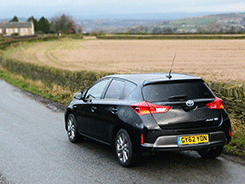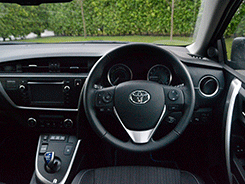First Driving Impressions – Toyota Auris
There’s nothing technically wrong with the current Auris; it’s well built, high in quality and uses some good materials throughout, but the design was a little old-fashioned before it even hit the roads. Many people described it as dull and trying to progress further into the C sector hatch market with this car was always going to be an uphill battle. Toyota took a very brave decision early in the Auris’s life and decided to bring forward its replacement, cut its losses and start again. The all-new Auris is quite literally all-new, and its design is now as modern as anything else in the market.
They have thought about every last detail, ensuring that it’s all in proportion and pleasant on the eye.
 The public do like a well-built car with high quality, reliability, frugality and competitive pricing being the primary desires. They also want a good looking car: a car with style that makes a positive statement about them. The current Auris offered most of this but not all of it. The new car offers all of these attributes and more besides.
The public do like a well-built car with high quality, reliability, frugality and competitive pricing being the primary desires. They also want a good looking car: a car with style that makes a positive statement about them. The current Auris offered most of this but not all of it. The new car offers all of these attributes and more besides.
Toyota decided to start with some new nomenclature as they felt the public were ready for new badges and that a new car deserved a fresh start. The new badges are: Active, Icon, Sport and Excel, which don’t exactly roll off the tongue but they’re an improvement. People will no doubt get used to them and accept and understand them in time.
 The car’s exterior design has changed beyond recognition; it really does look great from every angle. The side in particular has some really nice lines that make it look masculine and very distinctive. The front end is also very modern, with its large, deep lower grille and fog lights that are positioned at the extremities of the front lower bumper, giving it a wide stance look and a dynamic appearance. The rear is very attractive and fits in with the rest of the car’s styling. It’s neat yet practical and has LED lights and a sporty piano black diffuser, although the rear diffuser might not be to everyone’s taste. The design team have got it right with this new car, rectifying all that was wrong with the previous one. They have thought about every last detail, ensuring that it’s all in proportion and pleasant on the eye.
The car’s exterior design has changed beyond recognition; it really does look great from every angle. The side in particular has some really nice lines that make it look masculine and very distinctive. The front end is also very modern, with its large, deep lower grille and fog lights that are positioned at the extremities of the front lower bumper, giving it a wide stance look and a dynamic appearance. The rear is very attractive and fits in with the rest of the car’s styling. It’s neat yet practical and has LED lights and a sporty piano black diffuser, although the rear diffuser might not be to everyone’s taste. The design team have got it right with this new car, rectifying all that was wrong with the previous one. They have thought about every last detail, ensuring that it’s all in proportion and pleasant on the eye.
 The interior is also a big leap forward, with the use of soft touch materials being evident throughout. This will not have been cheap to produce, but it does increase the quality feel. What we did particularly like was the stitching on the upper dash as this also gives it a real premium touch and feel. The Nappa leather steering wheel also adds a nice touch, but my favourite piece of detailing is the satin silver finish around the gear stick, air vents, door handles and the multimedia screen. All the materials used are consistent and all add up to a huge improvement in the cabin. The one thing we didn’t like was the digital clock, which looks so out of place and from another decade. A nice oval or circular clock with a matching silver satin finish would have made the interior perfect but Toyota in their wisdom decided to fit a low price, low quality clock and hoped they could get away with it.
The interior is also a big leap forward, with the use of soft touch materials being evident throughout. This will not have been cheap to produce, but it does increase the quality feel. What we did particularly like was the stitching on the upper dash as this also gives it a real premium touch and feel. The Nappa leather steering wheel also adds a nice touch, but my favourite piece of detailing is the satin silver finish around the gear stick, air vents, door handles and the multimedia screen. All the materials used are consistent and all add up to a huge improvement in the cabin. The one thing we didn’t like was the digital clock, which looks so out of place and from another decade. A nice oval or circular clock with a matching silver satin finish would have made the interior perfect but Toyota in their wisdom decided to fit a low price, low quality clock and hoped they could get away with it.
We have test driven two engines so far: the 1.4 litre diesel – which produces 90ps and is coupled to a 6 speed manual gearbox – and the 1.8 litre petrol hybrid that produces134ps. Both the diesel and the petrol hybrid engines have, strangely enough, a combined MPG figure of 72.4. Having driven the hybrid extensively in towns, motorways and up and down the local hills, it achieved around 50 MPG according to the on-board computer, which is way off the official figure, but still not bad for a 1.8 litre.
Driving the hybrid is so easy: you just press the start button, put the gearshift into drive and away you go quietly and efficiently. The engine cuts in fairly soon after setting off and the hybrid system tries to recover lost energy whenever possible; this can all be monitored by looking at the display in front of the driver. You can press the EV mode button and it will run for a while up to speeds of around 15mph on pure electric power. It’s a very clever system and this latest version is yet another step forward for this technology. The hybrid engine is coupled to a CVT automatic transmission, which is more advanced than that in the previous models as it’s much smoother and a whole lot quieter. The previous CVTs were a bit noisy and felt as though they were slipping. On paper the 1.4 litre diesel engine doesn’t sound as though it’s that powerful with just 90ps, but in reality it works perfectly well, although when we drove the cars there were only two of us in it, plus its large boot was empty. Under normal circumstances the car gets away from traffic lights and road junctions with ease and on the motorway it will maintain 70mph, even when going up some fairly steep inclines. This 1.4 litre diesel has a CO2 emissions figure that sits in the 99g/km to 102g/km range, which leaves you wondering if they’ve missed a trick here by not reaching the new and all-important fleet benchmark figure of 94g/km. Toyota say for the time being they do not intend on bringing in the more powerful 2.0 litre unit to the UK, although this engine will be available in other European countries. The lack of this engine here might put some customers off, so a quick decision needs to be made to ensure a potential gap is filled.
It’s a nice car to drive; it’s quiet and refined, comfortable and it feels rock solid. The quality is of a high standard and it is reasonably frugal on the fuel and its CO2 figure is equally acceptable. Will the Auris badge and its not so positive history simply prevent customers from going into showrooms? Will this new model ultimately get tarred with the same brush? I hope not, as this new version is a big leap forward compared to the previous model and makes the Auris a better proposition in this competitive and often crowded sector.
The Auris’s main competitors are Ford Focus, VW Golf, Vauxhall Astra, Peugeot 308, Hyundai i30, Kia Cee’d, Renault Megane and possibly the Volvo V40. Prices start from £14,495 and go up to £21,745.





